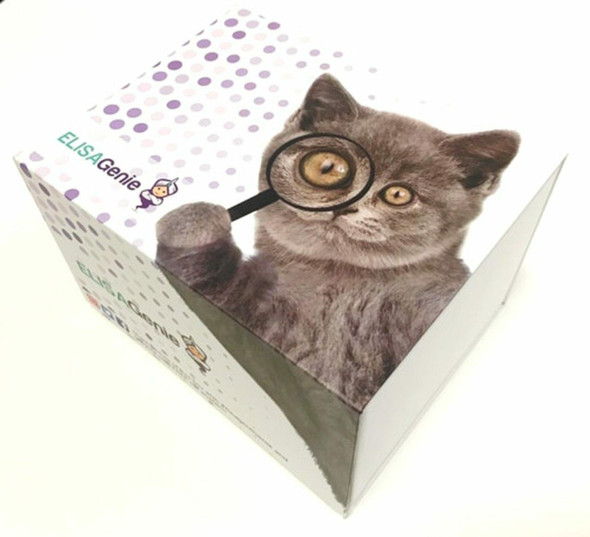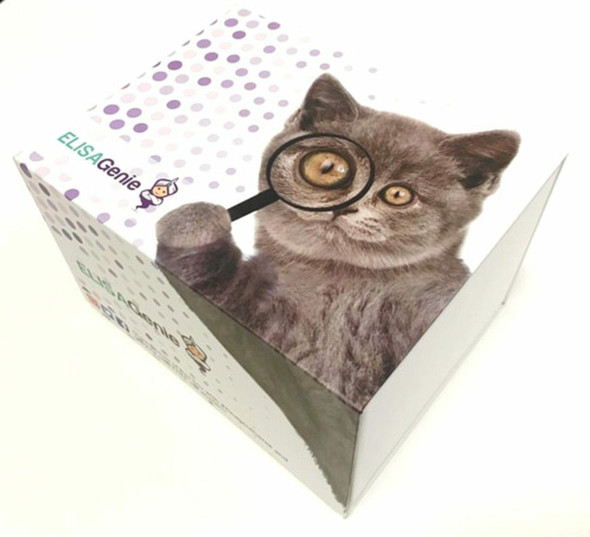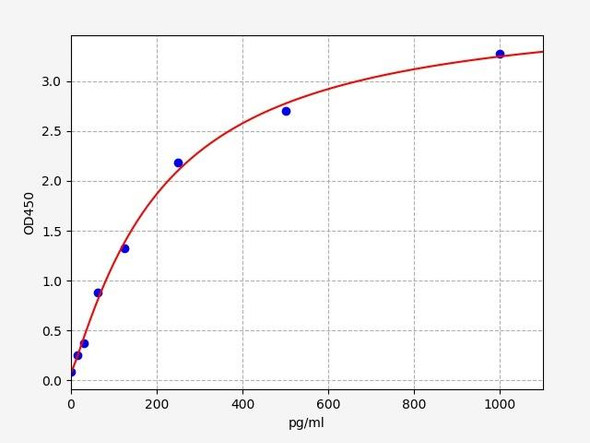Human Suppressor of cytokine signaling 1 (SOCS1) ELISA Kit (HUEB1494)
- SKU:
- HUEB1494
- Product Type:
- ELISA Kit
- Size:
- 96 Assays
- Uniprot:
- O15524
- Range:
- 0.156-10 ng/mL
- ELISA Type:
- Sandwich
- Synonyms:
- SOCS1, Suppressor of cytokine signaling 1, SOCS-1
- Reactivity:
- Human
Description
Human Suppressor of cytokine signaling 1 (SOCS1) ELISA Kit
The Human Suppressor of Cytokine Signaling 1 (SOCS1) ELISA Kit is designed for the precise measurement of SOCS1 levels in human serum, plasma, and cell culture supernatants. This kit offers exceptional sensitivity and specificity, ensuring accurate and consistent results for various research applications.SOCS1 is a key regulator of cytokine signaling pathways, acting as a negative feedback regulator to control immune responses and inflammation. Dysregulation of SOCS1 has been linked to various diseases, including autoimmune disorders and cancer, highlighting its importance as a potential therapeutic target and biomarker for disease progression.
By using the Human SOCS1 ELISA Kit, researchers can gain valuable insights into the role of SOCS1 in disease pathogenesis and develop targeted therapies for conditions where SOCS1 dysregulation plays a critical role. Trust in the reliability and performance of this ELISA kit for your research needs.
| Product Name: | Human Suppressor of cytokine signaling 1 (SOCS1) ELISA Kit |
| SKU: | HUEB1494 |
| Size: | 96T |
| Target: | Human Suppressor of cytokine signaling 1 (SOCS1) |
| Synonyms: | JAK-binding protein, STAT-induced STAT inhibitor 1, Tec-interacting protein 3, JAB, SSI-1, TIP-3, SOCS-1, SSI1, TIP3 |
| Assay Type: | Sandwich |
| Detection Method: | ELISA |
| Reactivity: | Human |
| Detection Range: | 0.156-10ng/mL |
| Sensitivity: | 0.072ng/mL |
| Intra CV: | 3.2% | ||||||||||||||||||||
| Inter CV: | 6.4% | ||||||||||||||||||||
| Linearity: |
| ||||||||||||||||||||
| Recovery: |
| ||||||||||||||||||||
| Function: | SOCS family proteins form part of a classical negative feedback system that regulates cytokine signal transduction. SOCS1 is involved in negative regulation of cytokines that signal through the JAK/STAT3 pathway. Through binding to JAKs, inhibits their kinase activity. In vitro, also suppresses Tec protein-tyrosine activity. Appears to be a major regulator of signaling by interleukin 6 (IL6) and leukemia inhibitory factor (LIF). Regulates interferon-gamma mediated sensory neuron survival (By similarity). Probable substrate recognition component of an ECS (Elongin BC-CUL2/5-SOCS-box protein) E3 ubiquitin ligase complex which mediates the ubiquitination and subsequent proteasomal degradation of target proteins. Seems to recognize JAK2. SOCS1 appears to be a negative regulator in IGF1R signaling pathway. |
| Uniprot: | O15524 |
| Sample Type: | Serum, plasma, tissue homogenates, cell culture supernates and other biological fluids |
| Specificity: | Natural and recombinant human Suppressor of cytokine signaling 1 |
| Sub Unit: | Interacts with multiple activated signaling proteins of the tyrosine kinase signaling pathway including JAK family kinases, TEC, KIT, GRB2 and VAV. Binding to JAKs is mediated through the KIR and SH2 domains to a phosphorylated tyrosine residue within the JAK JH1 domain. Binds the SH3 domain of GRB2 via diproline determinants in the N-terminus, and the N-terminal regulatory domain of VAV (By similarity). Interacts with the Elongin BC complex (ELOB and ELOC). Component of an ECS CBC(SOCS1) E3 ubiquitin-protein ligase complex which contains Elongin BC, CUL5, RBX1 and SOCS1 (By similarity). Interacts (via SH2 domain and SOCS box) with TRIM8 (By similarity). Interacts with AXL, CUL2 and FGFR3. Interacts with INSR. |
| Research Area: | Immunology |
| Subcellular Location: | Nucleus Cytoplasmic vesicle Detected in perinuclear cytoplasmic vesicles upon interaction with FGFR3. |
| Storage: | Please see kit components below for exact storage details |
| Note: | For research use only |
| UniProt Protein Function: | SOCS1: SOCS family proteins form part of a classical negative feedback system that regulates cytokine signal transduction. SOCS1 is involved in negative regulation of cytokines that signal through the JAK/STAT3 pathway. Through binding to JAKs, inhibits their kinase activity. In vitro, also suppresses Tec protein- tyrosine activity. Appears to be a major regulator of signaling by interleukin 6 (IL6) and leukemia inhibitory factor (LIF). Regulates interferon-gamma mediated sensory neuron survival. Probable substrate recognition component of an ECS (Elongin BC-CUL2/5-SOCS-box protein) E3 ubiquitin ligase complex which mediates the ubiquitination and subsequent proteasomal degradation of target proteins. Seems to recognize JAK2. SOCS1 appears to be a negative regulator in IGF1R signaling pathway. Interacts with multiple activated signaling proteins of the tyrosine kinase signaling pathway including JAK family kinases, TEC, KIT, GRB2 and VAV. Binding to JAKs is mediated through the KIR and SH2 domains to a phosphorylated tyrosine residue within the JAK JH1 domain. Binds the SH3 domain of GRB2 via diproline determinants in the N-terminus, and the N-terminal regulatory domain of VAV. Interacts with the Elongin BC complex (TCEB1 and TCEB2). Component of an ECS CBC(SOCS1) E3 ubiquitin-protein ligase complex which contains Elongin BC, CUL5, RBX1 and SOCS1. Interacts (via SH2 domain and SOCS box) with TRIM8. Interacts with AXL, CUL2 and FGFR3. Interacts with INSR. By a subset of cytokines including those belonging to the interferon, interleukin and colony-stimulating factor families. Expressed in all tissues with high expression in spleen, small intestine and peripheral blood leukocytes. |
| UniProt Protein Details: | Protein type:Inhibitor Chromosomal Location of Human Ortholog: 16p13.13 Cellular Component: cytoplasm; cytoplasmic membrane-bound vesicle; cytosol; nucleus Molecular Function:insulin-like growth factor receptor binding; protein binding; protein kinase inhibitor activity; kinase inhibitor activity; protein kinase binding Biological Process: fat cell differentiation; regulation of protein amino acid phosphorylation; cytokine and chemokine mediated signaling pathway; regulation of growth; negative regulation of tyrosine phosphorylation of Stat3 protein; negative regulation of insulin receptor signaling pathway; protein ubiquitination; negative regulation of protein kinase activity; JAK-STAT cascade; negative regulation of JAK-STAT cascade |
| NCBI Summary: | This gene encodes a member of the STAT-induced STAT inhibitor (SSI), also known as suppressor of cytokine signaling (SOCS), family. SSI family members are cytokine-inducible negative regulators of cytokine signaling. The expression of this gene can be induced by a subset of cytokines, including IL2, IL3 erythropoietin (EPO), CSF2/GM-CSF, and interferon (IFN)-gamma. The protein encoded by this gene functions downstream of cytokine receptors, and takes part in a negative feedback loop to attenuate cytokine signaling. Knockout studies in mice suggested the role of this gene as a modulator of IFN-gamma action, which is required for normal postnatal growth and survival. [provided by RefSeq, Jul 2008] |
| UniProt Code: | O15524 |
| NCBI GenInfo Identifier: | 20178097 |
| NCBI Gene ID: | 8651 |
| NCBI Accession: | O15524.1 |
| UniProt Secondary Accession: | O15524,O15097, Q9NSA7, |
| UniProt Related Accession: | O15524 |
| Molecular Weight: | |
| NCBI Full Name: | Suppressor of cytokine signaling 1 |
| NCBI Synonym Full Names: | suppressor of cytokine signaling 1 |
| NCBI Official Symbol: | SOCS1 |
| NCBI Official Synonym Symbols: | JAB; CIS1; SSI1; TIP3; CISH1; SSI-1; SOCS-1 |
| NCBI Protein Information: | suppressor of cytokine signaling 1; TIP-3; JAK binding protein; JAK-binding protein; Tec-interacting protein 3; STAT induced SH3 protein 1; STAT-induced STAT inhibitor 1; cytokine-inducible SH2 protein 1 |
| UniProt Protein Name: | Suppressor of cytokine signaling 1 |
| UniProt Synonym Protein Names: | JAK-binding protein; JAB; STAT-induced STAT inhibitor 1; SSI-1; Tec-interacting protein 3; TIP-3 |
| Protein Family: | Suppressor of cytokine signaling |
| UniProt Gene Name: | SOCS1 |
| UniProt Entry Name: | SOCS1_HUMAN |
| Component | Quantity (96 Assays) | Storage |
| ELISA Microplate (Dismountable) | 8×12 strips | -20°C |
| Lyophilized Standard | 2 | -20°C |
| Sample Diluent | 20ml | -20°C |
| Assay Diluent A | 10mL | -20°C |
| Assay Diluent B | 10mL | -20°C |
| Detection Reagent A | 120µL | -20°C |
| Detection Reagent B | 120µL | -20°C |
| Wash Buffer | 30mL | 4°C |
| Substrate | 10mL | 4°C |
| Stop Solution | 10mL | 4°C |
| Plate Sealer | 5 | - |
Other materials and equipment required:
- Microplate reader with 450 nm wavelength filter
- Multichannel Pipette, Pipette, microcentrifuge tubes and disposable pipette tips
- Incubator
- Deionized or distilled water
- Absorbent paper
- Buffer resevoir
*Note: The below protocol is a sample protocol. Protocols are specific to each batch/lot. For the correct instructions please follow the protocol included in your kit.
Allow all reagents to reach room temperature (Please do not dissolve the reagents at 37°C directly). All the reagents should be mixed thoroughly by gently swirling before pipetting. Avoid foaming. Keep appropriate numbers of strips for 1 experiment and remove extra strips from microtiter plate. Removed strips should be resealed and stored at -20°C until the kits expiry date. Prepare all reagents, working standards and samples as directed in the previous sections. Please predict the concentration before assaying. If values for these are not within the range of the standard curve, users must determine the optimal sample dilutions for their experiments. We recommend running all samples in duplicate.
| Step | |
| 1. | Add Sample: Add 100µL of Standard, Blank, or Sample per well. The blank well is added with Sample diluent. Solutions are added to the bottom of micro ELISA plate well, avoid inside wall touching and foaming as possible. Mix it gently. Cover the plate with sealer we provided. Incubate for 120 minutes at 37°C. |
| 2. | Remove the liquid from each well, don't wash. Add 100µL of Detection Reagent A working solution to each well. Cover with the Plate sealer. Gently tap the plate to ensure thorough mixing. Incubate for 1 hour at 37°C. Note: if Detection Reagent A appears cloudy warm to room temperature until solution is uniform. |
| 3. | Aspirate each well and wash, repeating the process three times. Wash by filling each well with Wash Buffer (approximately 400µL) (a squirt bottle, multi-channel pipette,manifold dispenser or automated washer are needed). Complete removal of liquid at each step is essential. After the last wash, completely remove remaining Wash Buffer by aspirating or decanting. Invert the plate and pat it against thick clean absorbent paper. |
| 4. | Add 100µL of Detection Reagent B working solution to each well. Cover with the Plate sealer. Incubate for 60 minutes at 37°C. |
| 5. | Repeat the wash process for five times as conducted in step 3. |
| 6. | Add 90µL of Substrate Solution to each well. Cover with a new Plate sealer and incubate for 10-20 minutes at 37°C. Protect the plate from light. The reaction time can be shortened or extended according to the actual color change, but this should not exceed more than 30 minutes. When apparent gradient appears in standard wells, user should terminatethe reaction. |
| 7. | Add 50µL of Stop Solution to each well. If color change does not appear uniform, gently tap the plate to ensure thorough mixing. |
| 8. | Determine the optical density (OD value) of each well at once, using a micro-plate reader set to 450 nm. User should open the micro-plate reader in advance, preheat the instrument, and set the testing parameters. |
| 9. | After experiment, store all reagents according to the specified storage temperature respectively until their expiry. |
When carrying out an ELISA assay it is important to prepare your samples in order to achieve the best possible results. Below we have a list of procedures for the preparation of samples for different sample types.
| Sample Type | Protocol |
| Serum | If using serum separator tubes, allow samples to clot for 30 minutes at room temperature. Centrifuge for 10 minutes at 1,000x g. Collect the serum fraction and assay promptly or aliquot and store the samples at -80°C. Avoid multiple freeze-thaw cycles. If serum separator tubes are not being used, allow samples to clot overnight at 2-8°C. Centrifuge for 10 minutes at 1,000x g. Remove serum and assay promptly or aliquot and store the samples at -80°C. Avoid multiple freeze-thaw cycles. |
| Plasma | Collect plasma using EDTA or heparin as an anticoagulant. Centrifuge samples at 4°C for 15 mins at 1000 × g within 30 mins of collection. Collect the plasma fraction and assay promptly or aliquot and store the samples at -80°C. Avoid multiple freeze-thaw cycles. Note: Over haemolysed samples are not suitable for use with this kit. |
| Urine & Cerebrospinal Fluid | Collect the urine (mid-stream) in a sterile container, centrifuge for 20 mins at 2000-3000 rpm. Remove supernatant and assay immediately. If any precipitation is detected, repeat the centrifugation step. A similar protocol can be used for cerebrospinal fluid. |
| Cell culture supernatant | Collect the cell culture media by pipette, followed by centrifugation at 4°C for 20 mins at 1500 rpm. Collect the clear supernatant and assay immediately. |
| Cell lysates | Solubilize cells in lysis buffer and allow to sit on ice for 30 minutes. Centrifuge tubes at 14,000 x g for 5 minutes to remove insoluble material. Aliquot the supernatant into a new tube and discard the remaining whole cell extract. Quantify total protein concentration using a total protein assay. Assay immediately or aliquot and store at ≤ -20 °C. |
| Tissue homogenates | The preparation of tissue homogenates will vary depending upon tissue type. Rinse tissue with 1X PBS to remove excess blood & homogenize in 20ml of 1X PBS (including protease inhibitors) and store overnight at ≤ -20°C. Two freeze-thaw cycles are required to break the cell membranes. To further disrupt the cell membranes you can sonicate the samples. Centrifuge homogenates for 5 mins at 5000xg. Remove the supernatant and assay immediately or aliquot and store at -20°C or -80°C. |
| Tissue lysates | Rinse tissue with PBS, cut into 1-2 mm pieces, and homogenize with a tissue homogenizer in PBS. Add an equal volume of RIPA buffer containing protease inhibitors and lyse tissues at room temperature for 30 minutes with gentle agitation. Centrifuge to remove debris. Quantify total protein concentration using a total protein assay. Assay immediately or aliquot and store at ≤ -20 °C. |
| Breast Milk | Collect milk samples and centrifuge at 10,000 x g for 60 min at 4°C. Aliquot the supernatant and assay. For long term use, store samples at -80°C. Minimize freeze/thaw cycles. |










